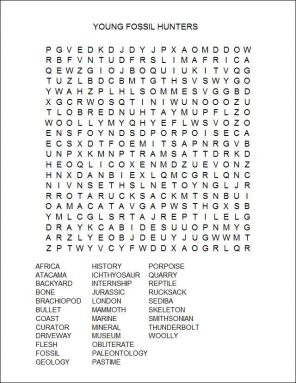Fossil hunting can start as child’s play
Paleontology isn’t just for professionals, as many kids learn
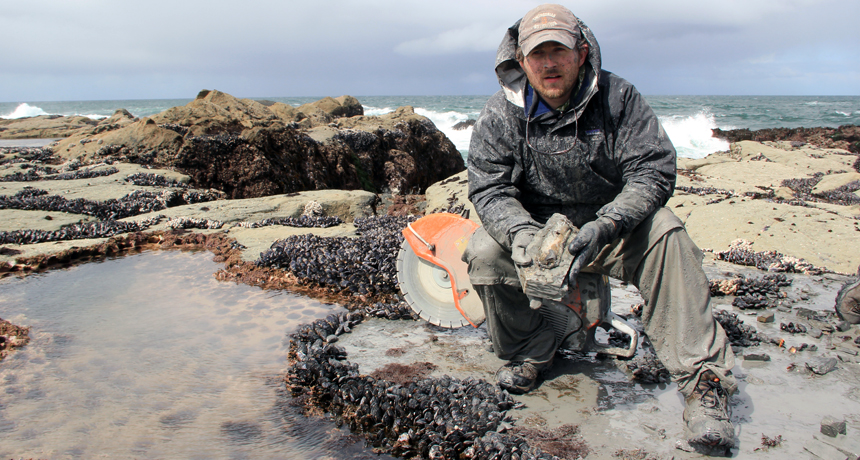
Nicholas Pyenson holds the fossil arm bone of an extinct whale unearthed along the coast of Vancouver Island in 2012. Paleontologists sometimes need to use heavy equipment, such as the power saw seen here, to pry a fossil loose. Pyenson is one of many scientists who found their love of fossils in childhood.
J.A. Goldbogen
Trains fascinated Paul Taylor when he was a young boy growing up in northern England. Sometimes he would follow an abandoned track, looking for keepsakes to cart home.
On one of those walks, when he was 12 or 13, Paul came upon a great pile of rocks by the side of the tracks. Dug from a nearby quarry, the pile was full of things didn’t look like regular stones. The boy filled his rucksack with these finds and took them home to show his dad. His father looked at some bullet-shaped rocks and said they were “thunderbolts.” Paul actually had found the long and pointy fossils of squidlike belemnites. The fossils had preserved hard parts of the creatures, an extinct kind of cephalopod (SEFF-uh-lo-pod). These invertebrates (animals lacking backbones) last swam the seas in Jurassic times, around 175 million years ago.
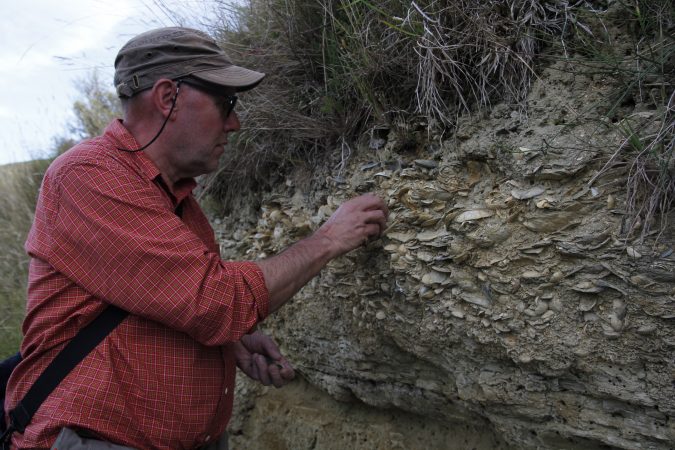
Paleontology (PAY-lee-un-TAHL-uh-gee) is the study of fossils. Fossils are the remains or impressions of ancient life, often preserved in rock. Paleontology is one of the few fields of science in which people of any age or educational level can participate. Even nonscientists, “can go out and make a discovery,” Taylor says. “You can find something that’s 180 million years old, hold it in your hand and be the first person to do that.”
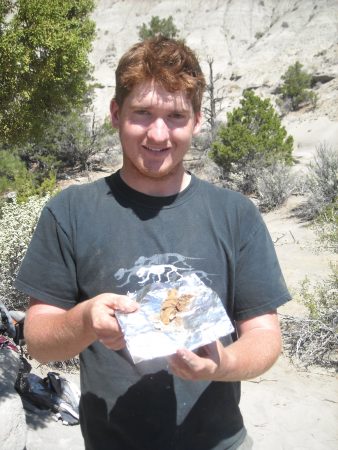
Here we meet several people who found their first fossils as children. In some cases, those remnants of the far-distant past so captivated their imagination that they wouldn’t let go. Today, they still hunt fossils, even as adults. Their early passion has become their profession.
Rocking it in the field
Most amateur fossil hunters don’t make discoveries that end up being reported in scientific journals or displayed in museums. But some do.
In 2009, Kevin Terris had just finished his senior year of high school when he joined a field trip to the Grand Staircase-Escalante National Monument in southern Utah. While hiking, he spotted a piece of exposed bone. What he had found was the skull of a tube-crested dinosaur called Parasaurolophus (PAIR ah SOR oh LOFF us). The teen’s find led to the discovery of a nearly complete skeleton of the baby dinosaur, nicknamed “Joe.” Three of Kevin’s classmates from The Webb Schools in Claremont, Calif. — Derek Chok, Annisa Herrero and Brandon Scolieri — helped analyze the bones. The three were among the authors on a scientific paper describing the skeleton. It was published in October 2013 in PeerJ, a scientific journal.
Not everything that dies ends up in the fossil record. Dinosaurs are spectacular but rare finds. They lived from roughly 231 million to 66 million years ago. That’s just a small amount of time on a planet that’s been around for 4.54 billion years. Dinosaur fossils also are rare because small organisms lower on the food chain tend to be more numerous.
The most common fossils are from organisms whose bodies included hard shells or bones. Those hard parts take longer to decompose than does flesh. That’s why they are more likely to stick around long enough to become fossilized.
When hunting fossils, the kinds of finds that will turn up in a particular location often reflect the very different environment that existed there long ago. Rocks that once were ocean floor may contain nautilus-like ammonites, bug-like trilobites or the shells of brachiopods. Rocks that were once river bottom might hold the fossils of land animals washed downstream long ago. Sometimes, rock will even preserve what are called trace fossils, such as footprints or burrows. Scientists have even found in sandstones in Australia the fossils of microscopic cells that lived on a pebbly island beach a whopping 3.4 billion years ago.
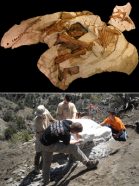
Matthew’s father and his colleagues soon dug up two skeletons that looked similar to humans. They were an entirely new species that would come to be named Australopithecus sediba. Scientists estimate that this human relative lived 1.8 million to 2 million years ago.
A mammoth passion
Not all young fossil hunters need scientist parents if they want to take up the pastime. Carolyn Levitt-Bussian got hooked on a family trip to the Mammoth Site in Hot Springs, S.D., when she was 11. Beginning in 1974, excavators at the site have been unearthing the remains of dozens of woolly mammoths. The mammoths had died about 26,000 years ago. They had become trapped in a pond that filled a sinkhole. Eventually, their bones became fossils.
Scientists and volunteers are still digging up fossils in the sediments that had filled the ancient sinkhole. They have uncovered the remains of mammals, including wolves, llamas and giant short-faced bears. They also have unearthed fish, clams and snails. And they have found mammoths, of course — 59 to date.
Now an adult, Levitt-Bussian describes that first visit to the Mammoth Site as “the day that changed my life.” The site’s director, Larry Agenbroad, came up to her as she was walking around and taking pictures. “He was so nice and so gracious and answered all my questions,” Levitt-Bussian says. He also gave her his email address. They started exchanging messages. Four years later, Agenbroad invited her to come back and dig for fossils.
And the girl jumped at the chance.
For two weeks, Levitt-Bussian, then just 15, worked with a team from the Earthwatch Institute, which connects volunteers with scientific expeditions. “I found a mammoth footprint,” she remembers. The teen also learned more about mammoths and about how to excavate fossils. The next year, Levitt-Bussian returned. This time, she found a humerus. The bone came from the upper arm of a giant short-faced bear.
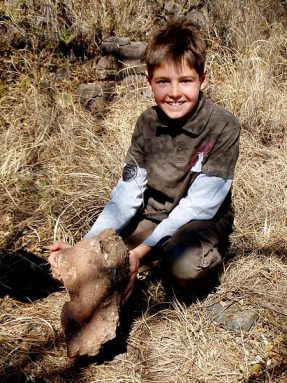
Today, Levitt-Bussian manages the paleontology collections at the Natural History Museum of Utah in Salt Lake City. She keeps track of the fossils as they enter and leave the museum. A museum doesn’t just hold fossils for display. It’s a site of active research. It even may loan fossils to scientists from around the world to study. “We are preserving these fossils for the future,” she explains.
Levitt-Bussian acknowledges she was fortunate to go on a dig as a teen. She stresses there are plenty of other ways to get involved in paleontology, too. Her museum, for instance, hires interns and arranges for students to “shadow” staff scientists, following them around and watching what they do. Other museums, she notes, offer programs that allow volunteers to help collect or clean fossils.
Where to look
At many sites around the world with rich fossil deposits, only scientists or people who work with them are now allowed to remove those ancient remains. Luckily for amateur fossil hunters, there are exceptions. The Jurassic Coast of southeast England is one such site. Here, fossils constantly wash out of the cliffs and onto the beach. If not picked up, they soon disappear into the sea. So the site’s managers encourage fossil hunters to root around on the beaches. While the managers encourage visitors to show them any interesting finds, they remain free to take home the fossils they spy.
Not surprisingly, this region has a long history of attracting young fossil hunters. In fact, it’s where Mary Anninggot her start in the early 1800s. Sometimes called the greatest fossil hunter ever, she lived in a town called Lyme Regis along the Jurassic Coast. When just 11, Anning spent several months overseeing the removal of a large skeleton from a cliff face, where her brother, Joseph, had first spied it.
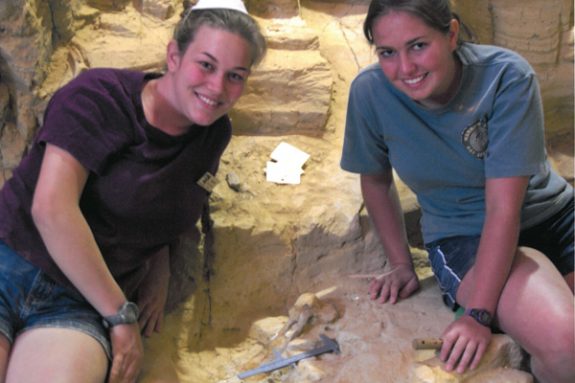
The skeleton turned out to be a fossil of the world’s first known ichthyosaur. A giant marine reptile, it resembled a modern porpoise. Anning would go on to discover many more fossil remains along the Jurassic Coast. A large number of them ended up in museums, including the Natural History Museum in London.
Throughout the year, whole families can be spotted scouring the same beaches Anning searched. Foraging for an hour or two can turn up dozens of fossils to take home. This reporter found ammonites, belemnites and even a sea urchin during her searches on the Jurassic Coast.
Fossil hunters here have to be careful to avoid incoming tides and falling rocks. And there are rules on what can be taken away and what kinds of tools may be used. Fossil hunters, for instance, can only use small hammers. And they may not dig into the cliff without permission.
Amateur fossil hunters also are welcome at Calvert Cliffs State Park and nearby beaches on the Chesapeake Bay in Maryland, and at Mineral Wells Fossil Park in Texas. No laws keep people from collecting any fossils they find at either park. At other sites, such as on lands belonging to the U.S. Bureau of Land Management, laws do limit what types of fossils people can take home. So before visiting a specific site, fossil hunters should learn what laws say about searching for and keeping fossils. Just as importantly, they should learn about the local geology. Knowing something about a location’s ancient environment and what types of fossils might be found will give a better idea of what to look for.
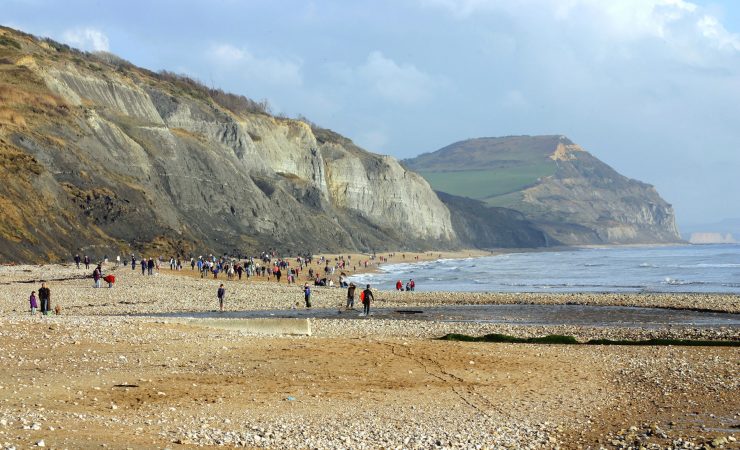
Sometimes young fossil hunters just luck out. Nicholas Pyenson sure did: He found ancient treasures without even leaving home.
As a boy in Montreal, Canada, “I was fascinated by the large boulders in my backyard,” he recalls. Retreating glaciers deposited them thousands of years before. “Inside, [the rocks] had all these wonderful little brachiopods,” he says, referring to a kind of ancient shellfish. Even more of the fossils could be found in front of his home. “I remember picking up brachiopods from the driveway,” where they were in the asphalt, he says.
Today, Pyenson is curator of fossil marine mammals at the Smithsonian Institution’s National Museum of Natural History in Washington, D.C. Despite the fossil hunting he enjoyed at home, Pyenson says it isn’t a necessary first step for anyone hoping to work as a paleontologist. What really got Pyenson excited about science were the trips he took with his family to natural history museums, including the Smithsonian and, nearer to home, the Redpath Museum in Montreal.
Despite his early exposures to fossils, Pyenson didn’t even decide to become a paleontologist until college. There, he read about expeditions to Africa. “The aspects of how romantic it was to search for fossils — that’s really kind of intoxicating stuff and it really captured my imagination,” he says. And, he adds: “That really rekindled this love I had when I was a kid.”
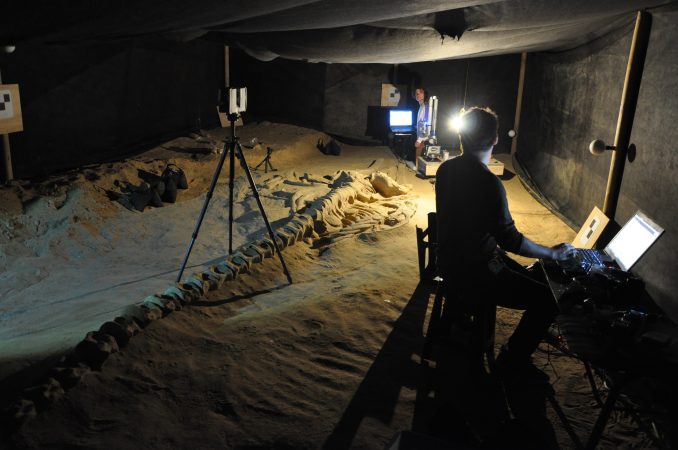
Nowadays, Pyenson doesn’t spend too much time searching for fossils. Instead, he works to carefully dig up and remove fossils discovered by others. In late 2011, for instance, he led a team of experts to a site in Chile’s Atacama Desert. There, construction workers had uncovered a cache of whale fossils by the side of a road. He and his colleagues quickly mapped out the site. Then also created 3-D images of how the fossils were arranged in the ground, before ongoing construction obliterated the site. “That was a huge challenge,” he recalls. But knowing how bones are arranged can help scientists learn about how the animals died.
As with many careers in science, becoming a professional paleontologist like Pyenson usually requires years of study. Most paleontologists, for example, have a PhD or other advanced degree. Still, Pyenson says that there’s something special about this field. Anyone can participate in fossil hunting. And, he adds, “any day someone can make an observation that changes everything.”
Power Words
ammonite An extinct cephalopod. This relative of modern-day squid and octopuses had a spiral-shaped shell, similar to a nautilus.
anthropology The study of humankind. A social scientist who studies different societies and cultures is called an anthropologist.
Australopithecus sediba A hominid species discovered in 2008 within caves at Malapa Nature Reserve in South Africa. Some anthropologists have argued that this species, which walked upright almost 2 million years ago, may be the most likely ancestor of the first Homo species.
belemnites A type of extinct cephalopod. These creatures often leave behind a fossil that looks like a bullet-shaped rock. That rock is what remains of an internal skeleton.
bivalve An invertebrate that lives in a two-part, hinged shell. Most bivalves filter their food from the waters that slosh past them. Bivalves include clams, oysters, scallops and mussels.
brachiopod A type of invertebrate that has a hinged shell. They resemble clams but are not mollusks. Brachiopods are among the oldest shelled invertebrates.
Bureau of Land Management An agency of the U.S. government that is part of the Department of the Interior. Among its many functions, this agency manages more than 887 different regions and approximately 27 million acres of National Monuments, National Conservation Areas, Wilderness Areas, Wilderness Study Areas, Wild and Scenic Rivers, National Scenic and Historic Trails and Conservation Lands of the California Desert. It issues rules on how these lands may be used and what minerals or other resources may be taken from them.
cephalopods Ocean-dwelling animals that include squid and octopuses.
curator Someone who manages a collection of items, for instance in a museum, library or art gallery. This person’s primary job is to design exhibits, organize and acquire collections and do research on the artifacts included in the collection.
dinosaur A term that means terrible lizard. These ancient reptiles lived from about 250 million years ago to roughly 65 million years ago. All descended from egg-laying reptiles known as archosaurs. Their descendants eventually split into two lines. They are distinguished by their hips. The lizard-hipped line became saurichians, such as two-footed theropods like T. rex and the lumbering four-footed Apatosaurus (once known as brontosaurus). A second line of so-called bird-hipped, or ornithischian dinosaurs, led to a widely differing group of animals that included the stegosaurs and duckbilled dinosaurs.
extinct An adjective that describes a species for which there are no living members.
fossil Any preserved remains or traces of ancient life. There are many different types of fossils: The bones and other body parts of dinosaurs are called “body fossils.” Things like footprints are called “trace fossils.” Even specimens of dinosaur poop are fossils.
Grand Staircase-Escalante National Monument A huge patch of public land spanning nearly 1.9 million acres (770,000 hectares) in the western United States. It gets the first part of its name from the Grand Staircase of cliffs and terraces that cross the rugged Kaiparowits Plateau. The second part of its name traces to its Escalante River Canyons. Owing to its being a rich source of dinosaur fossils, this monument has become popular among geologists, paleontologists, archeologists and others interested in scientific research.
fossil Any preserved remains or traces of ancient life. There are many different types of fossils: The bones and other body parts of dinosaurs are called “body fossils.” Things like footprints are called “trace fossils.” Even specimens of dinosaur poop may be preserved as fossils, called coprolites.
graduate degree An advanced degree that universities offer, such as a Master’s or PhD. These are called graduate degrees because someone usually qualifies to start work on them only after already graduating from college (usually with a four-year degree).
hominid A primate of an animal family that includes humans and their fossil ancestors.
humerus The long bone found in the upper arm or forearm of an animal.
ichthyosaur An extinct type of giant marine reptile that looked similar to a porpoise. Its name means “fish lizard.” Although not a dinosaur, it lived at the same time as dinosaurs.
internship A training program where students learn advanced professional skills by working alongside experts.People who participate in these training programs are called interns. Some interns work in medicine, others in the sciences, journalism or business.
intoxicating An adjective to describe something that can cause a sensory high (such as alcohol or certain other drugs) — or an event or condition that can also cause an extremely pleasurable sensation.
invertebrate An animal lacking a backbone. About 90 percent of animal species are invertebrates.
Jurassic Lasting from about 200 million to 145.5 million years ago, it’s the middle period of the Mesozoic Era, a time when dinosaurs were the dominant form of life on land.
mammal A warm-blooded animal distinguished by the possession of hair or fur, the secretion of milk by females for feeding the young, and (typically) the bearing of live young.
marine Having to do with the ocean world or environment.
mineral A chemical compound that is solid and stable at room temperatures and has a specific formula, or recipe (with atoms occurring in certain proportions) and a specific crystalline structure (meaning that its atoms are organized in certain regular three-dimensional patterns).
nautilus A type of cephalopod found in the South Pacific and Indian oceans and that has a spiral-shaped shell filled with chambers.
Parasaurolophus A genus of dinosaurs that lived around 75 million years ago. In 2009, teen Kevin Terris spotted a piece of exposed bone that led to the discovery of a baby Parasaurolophus.
paleontology The branch of science concerned with ancient, fossilized animals and plants. A scientist who works in this field is called a paleontologist.
PhD (also known as a doctorate) A type of advanced degree offered by universities — typically after five or six years of study — for work that creates new knowledge. People qualify to begin this type of graduate study only after having first completed a college degree (a program that typically takes four years of study).
sediment Material (such as stones and sand) deposited by water, wind or glaciers.
sinkhole A body of water that forms when a patch of ground opens up, revealing a rocky cavern below. That rocky structure then accumulates rainwater because there no opening below that allows the water to easily exit. Some sinkholes develop naturally. Others can result from the overpumping of any groundwater that may have collected in the rocky underground cavern. Sinkholes can be as small as a meter across or as large as a big lake.
trilobite An extinct group of arthropods that were related to modern-day insects.
woolly mammoth A type of extinct mammal that resembled a hairy elephant.
